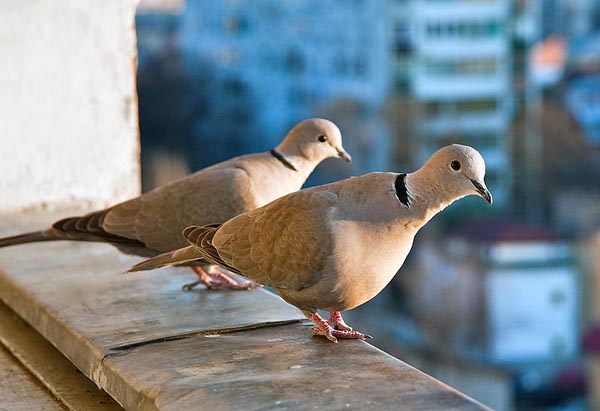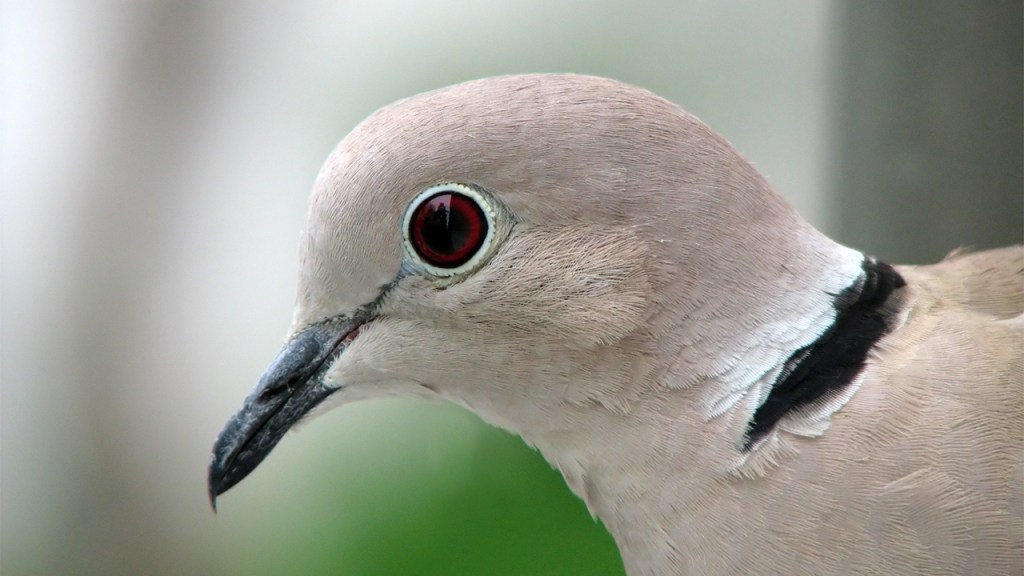The Great Backyard Bird Count (GBBC) — one of the largest citizen science initiatives in the world – annually documents a wide variety of bird population trends.
To my mind, one of the most interesting has been the dramatic spread of the non-native Eurasian collared dove across North America.
The GBBC asks citizen birders to watch an area for at least twenty minutes sometime during a four-day period in mid-February (this year’s count concluded yesterday), and record the birds they see.
Just ten years ago, seeing a Eurasian collared dove would have been a novelty. No more: the doves are now commonly reported by birders in most of the United States.
GBBC data tell the story of this rapid spread.
In the 1970s, the Eurasian collared dove was introduced to the Bahamas. By the early 1980s, the non-native birds made their way to South Florida, where they established populations. Then they began spreading north and west.
Their range appears to have expanded slowly at first. A look at GBBC reports from 1998 show a lot of sightings in Florida, with some birds reported in Texas, Alabama and Arkansas.
By 2001, the doves reached California.
Last year’s bird count results showed the Eurasian collared dove had colonized much of the country. It has not (yet) been reported in New England, but it has reached as far north as Alaska.
The GBBC’s video map dramatically illustrates this expansion.
In my state of Idaho, the doves were first recorded in 2005 by two backyard birders. In subsequent years, the bird was commonly reported in Idaho’s eastern corners. Last year, 132 GBBC participants reported 719 doves throughout the state.
I saw my first Eurasian collared dove in our backyard in 2008 – a banded bird that may have been an escaped pet. Last year, I began seeing the doves hanging around our neighborhood. This year was the first that I noted the species during my own participation in the Great Backyard Bird Count.
What’s going on here? Should conservationists be concerned about this spread?
Unlike some dove species, Eurasian collared doves aren’t migratory. However, they do readily expand into new suitable habitat. In fact, in their native Asia, Eurasian collared doves have been rapidly expanding their range as well – colonizing new countries every year.
The dove is one of those species that adapts well to humanity. The trees, power lines and bird feeders of suburbia provide perfect habitat. The Eurasian collared dove is almost always seen near homes and farms, not unbroken forest or prairie.
Research indicates it is not adversely affecting native mourning doves or other birds. It may simply be filling a new habitat niche created by suburban habitat. But it is still early in the spread.
Could Eurasian collared doves become an invasive threat? That remains to be seen.
Citizen science projects like the GBBC and another citizen initiative, Project FeederWatch, will help scientists continue to track the spread and impacts of the species. It will be interesting to learn what this year’s count found about Eurasian collared doves. If past years are any indication, their populations will likely have grown and spread into new areas of the country.
Have you seen Eurasian collared doves in your area? Have you noted other trends during your backyard bird counts? Let us know what you’re seeing!





We’ve been noticing Eurasian Collared Doves at Destruction Bay, Yukon for the past 3 years. Just yesterday I managed to photograph a pair at our feeding station. There is another collared dove that joins the pair while they eat. The pair have been at our neighbours feeder since March of this year and since we are gone during the day – didn’t notice the collared doves until the past couple of months. They are quite jittery but will come back to feed when quiet. Love their cooing – reminds me of the Hawaiian doves
There has been a very noticeable increase in the number of Collared doves here in the UK. I had never seen one until the 80s, now they seem to be everywhere.
They intimidate smaller birds, I have even seen one chase off an Eurasian Magpie. I now hardly ever see or hear smaller birds in my garden where there was once many.
They are beautiful birds, to look at, but their call is persistent and extremely irritating, very akin to a car alarm.
Its low frequency note punches through double glazed windows, and even some walls, and you only need to be able to “slightly” hear this noise for it to disrupt thought and sleep.
I have many Herring gulls in my town which squawk to each other throughout the day, I have no problem with them at all, in fact I like them while many complain.
The comments about the call of the Cooper Hawk has given inspiration; an air rifle has often crossed my mind whilst trying to work/think/sleep but could I actually kill them?
Could really do with some birds of prey here, those with a taste for collared doves.
Marc, let me know what happens when you play the call of the hawk. It has been almost six weeks and they are completely gone. Regards Trent
We have the Eurasian Collard Doves here in Campbell River BC , I have played the Cooper Hawk’s call and the doves have abanded their nest in the fir tree in our backyard . All is quiet now.
wow that is amazing
We have many here on our farm. They are not aggressive toward the Mourning doves! In fact both species nest in the same large evergreen trees. A few years ago there was an out break of West Nile Virus, and it wiped out both the Mourning doves as well as the ECDs. It took longer for the Mourning doves to replenish themselves, and I was sure the ECDs were gone for good. However, both types are back and doing well. These newcomers are not aggressive and many want to make them. As a hunter, I get upset with the gossip about them because I’m sure the other hunters want to make them an enemy; so they can shoot them without a limit.
Just saw my first one here in the north end of the Copper valley of Alaska (Slana).June 6 2015 7am.
These birds are a problem. I 3 years they have pushed out all of the mourning doves and White-wing doves in my neighborhood in Phoenix. They breed like rats. Something coordinated needs to be done about them and soon.
By the way, They taste great.
Play the call of the cooper’s hawk and they will fly away!
Also native doves fly away, right….
I saw two of these as well. Might not last long as we have a lot of birds of prey living here. Near Coeur d alene, ID.
Just saw 2 in my yard near Sacramento, CA.
I haven’t seen any wild ECDs where I live in Northern Virginia. I also haven’t seen as many mourning doves here as I used to see in New York State. But I own pet ringneck, or Barbary, doves, and when one of them lost its mate to illness a year ago, I purchased a new dove from a pet store in New York City (I couldn’t find any doves in the stores nearby me in VA). Right away I knew that there was something different about the new dove: It was bigger, stronger, and had a different call, and a friend of mine said it seemed like a different species. I did some research and decided that the dove (a young male) must be a Eurasian Collared dove. Now I wonder if the breeder/seller knew it was a ECD. It is a gorgeous dove. It gets along with the other doves and is less aggressive than the ringneck, or Barbary, dove males. It doesn’t fight with the other males and it doesn’t chase any female dove it sees. Maybe that’s the behavior of a new member of the little flock I have here? I really like its distinctive call, though the scream is a little startling. Fortunately, he does not scream very often.
This evening I was watching the usual solitary mourning dove eat the seeds I place on the ground for him. Then a collared dove swoops down, chases the mourning dove and eats the seed. These are aggressive, we gotta get rid of them.
Play the call of the Cooper’s Hawk and they will disappear. We did it and it has all been quiet for two weeks!
We have a pair of them using our feeders in Corvallos, Oregon.
I live in Lethbridge, Alberta, and saw my first Eurasian Collared Dove yesterday, May 9th. 2015. Today I disturbed three in my backyard and have heard them calling since. Looks like they have arrived here.
I live in the central Calif. Sierra foothills I have a pair Eurasian doves nesting 200 ft away from a cooper hawks nest in a cottonwood tree. They have not displaced any of the other species of birds that nest or eat here. Now the European starlings are another issue, they have taken over the local woodpeckers nesting holes.
Easy solution. We played the call of the Cooper’s Hawk and the Red Tailed Hawk, they beat it in one big hurry. It has been over two weeks. We live on the west coast on Vancouver Island, BC. best of luck!
Eurasian Collared Doves are unprotected in all 50 states and are considered an invasive species. They can be shot year around with no limits but subject to local firearm and airgun statutes. In Washington state you must have a small game license whether in or out of season. This is per conversation with the WDFW. These are larger than the common mourning dove and more aggressive but also more prone to flight around humans than the mourning dove. Mourning doves avoid and are displaced by the larger collared doves however.
I also saw a Coopers Hawk eat a Eurasian Dove on the top of a telephone pole outside our sliding glass door. He ate the whole thing after pulling the feathers out including the head first. Go Coopers Hawk!
In 2003 I was a biology undergrad in Little Rock, AR, and doing mosquito field research when I first encountered them near the airport, multiple times but only there. I brought it up with my ornithology professor and he figured I was mistaking mourning doves for Eurasians, so I take it they were not “supposed” to be in central AR at that time. I knew I was right though; no way you could mistake the big fat things that sound human-like. Seems like they’re kind of common around the area now.